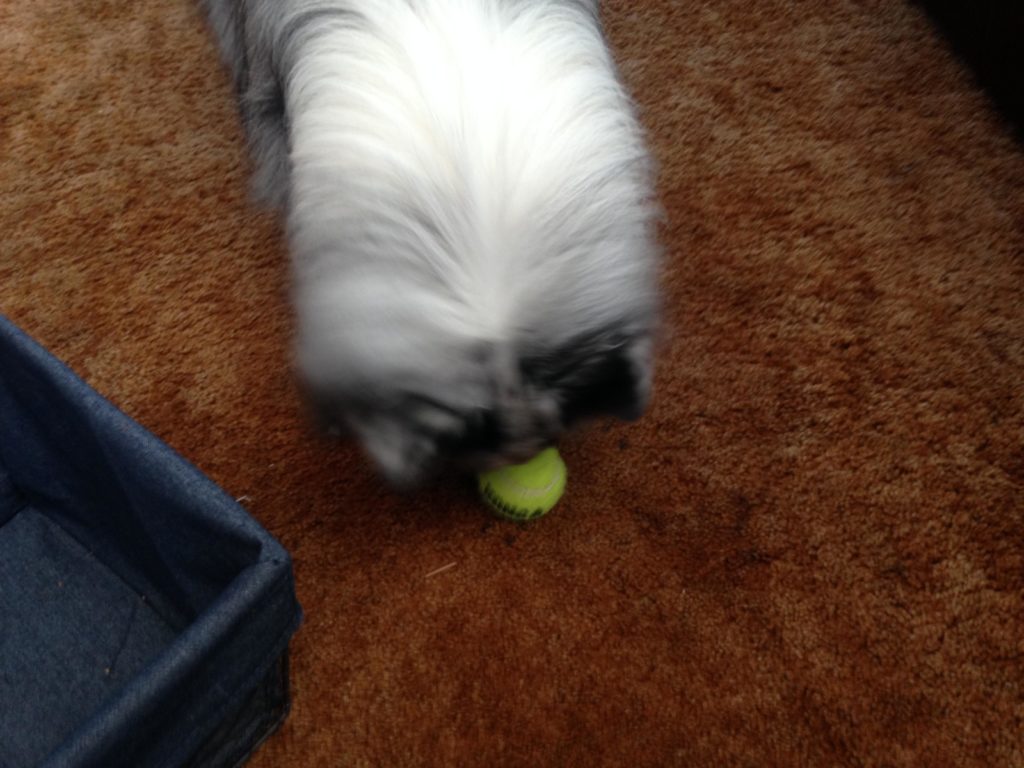Do you spend several minutes every day picking up your dog’s toys and putting them away? Most dogs are like kids – they get every toy they have and spread it around the house until it looks like a pet store tornado came through your house.

Why not teach your dog to clean up his own mess? It doesn’t just help you, it’s GREAT for your dog.
Why?
- Expends energy
- Makes him think (which also tires him out)
- Give him a job to do (dog bothering you while you are trying to cook or watch TV? Just tell him to go pick up his toys!)
It’s a bit of a complicated trick, and your dog needs to already be a fetcher to make it easy. If your dog doesn’t fetch, you can first teach him just to pick up the toy, but that is a lot longer process. For this article, we are going to assume your dog already fetches.
Set-up
- Box for toys
- A couple of your dog’s favorite toys
- Clicker (optional)
- Treats
Steps to Training Pick Up Toys
Step 1. Targeting the box
Put the box near you, since your dog is used to fetching to you, and toss your dog’s toy. If you use a cue for fetch, you can use it, but you don’t have to.
As your dog approaches you with his toy, point toward the box. Do NOT use a verbal cue yet!
If your dog drops the toy into the box, click or say “yes/good” etc., and drop a few treats into the box (this reinforces that the box is important).

If your dog does not drop the toy in the box, say nothing. Just toss the toy again, and try again. Placing the box directly in your dog’s line of retrieve – so it’s between you and him – can help him drop it in the box.
Step 2. Proofing
You want to make sure your dog understands that the toy must be in the box in order to get a treat. Once he is dropping it in the box almost every time (you are looking for that “magic” 80% or better!), move the box just a bit away from you (not too far, a couple inches is plenty!) and see if he still goes to drop the toy in.

If he does it successfully 8/10 times, you can continue to move the box further away.

If he does not, move the box back closer to you, he just wasn’t ready for it.
* REMEMBER TO REWARD YOUR DOG IN THE BOX!
Step 3. Picking up Stationary Toys
Once your dog is targeting the box, stop tossing the toy far. Instead, just lay out the toy near the box. If you have proofed the box enough, your dog will know that putting a toy into it will get him a reward.
If he doesn’t do it, then you may need to toss the toy just a bit, slowly building up to a non-moving toy.
Step 4. Adding The Cue
Once he is picking up a non-moving toy and placing it in the box, it’s time to add your cue. Say the cue as your dog drops the toy in the box.
Cue ideas:
- Clean Up
- Clean House
- Pick up Toys
- Tidy up
You can call it whatever you want – these are just a few suggestions.
Step 5. Adding more toys
Now that your dog has it on cue, you can start adding toys, one at a time at first. So, begin by saying your cue and rewarding him for picking up just one toy.
Then, put two toys out. After your dog picks up the first and drops it in – DO NOT REWARD! Wait him out. Your dog will search for something else he needs to do to get a reward and will most likely pick up that other toy and drop it in the box, at which point reward him well!
Related: 5 Best Dog Subscription Boxes

Continue to add toys one by one. Once you get to six or seven, your dog should understand he has to pick up all his toys to get his reward!
If he is not picking up the second toy, help him out by putting it close to the box or tossing it slightly like you did at the beginning when you were first teaching the trick.
Option – if you have an AutoTrainer or other type of treat dispenser, you can put it in the box to make training a bit easier. Dr. Sopia Yin has a video showing how to use one for this trick. You can watch it below:
Remember – it’s a trick and it’s supposed to be fun! If you or your dog is getting frustrated STOP! Do something else and come back to training this. It is a complicated trick and it may take a few weeks for your dog to get it. But it’s definitely worth it and a great trick to work on when the weather is bad.
 Toledo, United States.
Toledo, United States.